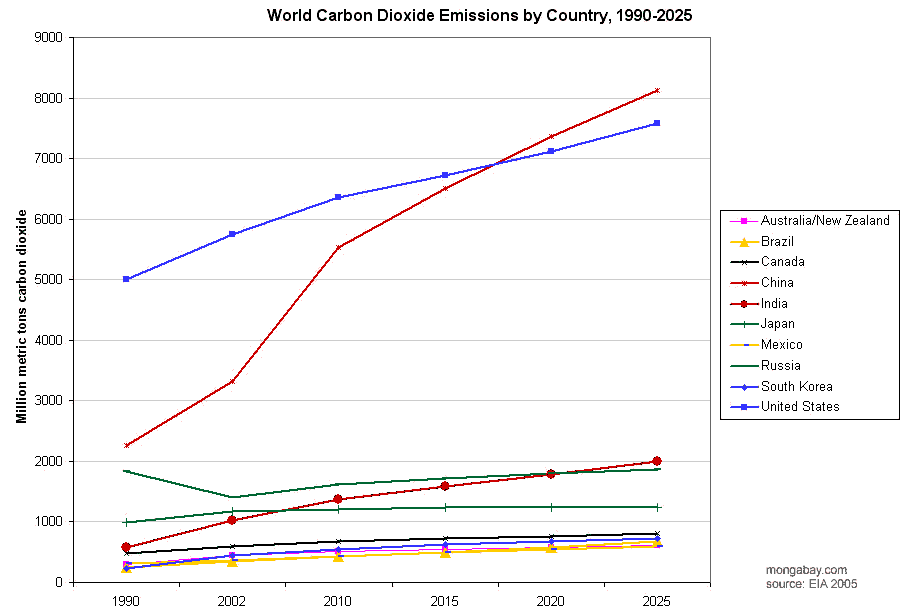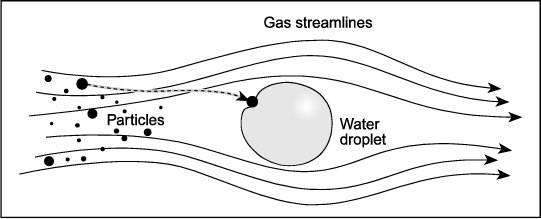|
Cyclonic Spray Scrubber
Cyclonic spray scrubbers are an air pollution control technology. They use the features of both the dry cyclone and the spray chamber to remove pollutants from gas streams. Generally, the inlet gas enters the chamber tangentially, swirls through the chamber in a corkscrew motion, and exits. At the same time, liquid is sprayed inside the chamber. As the gas swirls around the chamber, pollutants are removed when they impact on liquid droplets, are thrown to the walls, and washed back down and out. Cyclonic scrubbers are generally low- to medium-energy devices, with pressure drops of of water. Commercially available designs include the irrigated cyclone scrubber and the cyclonic spray scrubber. In the ''irrigated cyclone'' (Figure 1), the inlet gas enters near the top of the scrubber into the water sprays. The gas is forced to swirl downward, then change directions, and return upward in a tighter spiral. The liquid droplets produced capture the pollutants, are eventually thrown ... [...More Info...] [...Related Items...] OR: [Wikipedia] [Google] [Baidu] |
Venturi Scrubber
A venturi scrubber is designed to effectively use the energy from a high-velocity inlet gas stream to atomize the liquid being used to scrub the gas stream. This type of technology is a part of the group of air pollution controls collectively referred to as wet scrubbers. Venturis can be used to collect both particulate and gaseous pollutants, but although the liquid surface area provided is quite large they are more effective in removing particles since particles can be trapped by contact, but gases must be trapped by absorption during the relatively short exposure time. Venturi devices have also been used for over 100 years to measure fluid flow ( Venturi tubes derived their name from Giovanni Battista Venturi, an Italian physicist). In the late 1940s, H.F. Johnstone'','' William Jones, and other researchers found that they could effectively use the venturi configuration to remove particles from gas streams. Figure 1 illustrates the classic venturi configuration. [...More Info...] [...Related Items...] OR: [Wikipedia] [Google] [Baidu] |
Air Pollution Control Systems
An atmosphere () is a layer of gases that envelop an astronomical object, held in place by the gravity of the object. A planet retains an atmosphere when the gravity is great and the temperature of the atmosphere is low. A stellar atmosphere is the outer region of a star, which includes the layers above the opaque photosphere; stars of low temperature might have outer atmospheres containing compound molecules. The atmosphere of Earth is composed of nitrogen (78%), oxygen (21%), argon (0.9%), carbon dioxide (0.04%) and trace gases. Most organisms use oxygen for respiration; lightning and bacteria perform nitrogen fixation which produces ammonia that is used to make nucleotides and amino acids; plants, algae, and cyanobacteria use carbon dioxide for photosynthesis. The layered composition of the atmosphere minimises the harmful effects of sunlight, ultraviolet radiation, solar wind, and cosmic rays and thus protects the organisms from genetic damage. The current composition of t ... [...More Info...] [...Related Items...] OR: [Wikipedia] [Google] [Baidu] |
Pollution Control Technologies
Pollution is the introduction of contaminants into the natural environment that cause harm. Pollution can take the form of any substance (solid, liquid, or gas) or energy (such as radioactivity, heat, sound, or light). Pollutants, the components of pollution, can be either foreign substances/energies or naturally occurring contaminants. Although environmental pollution can be caused by natural events, the word pollution generally implies that the contaminants have a human source, such as manufacturing, extractive industries, poor waste management, transportation or agriculture. Pollution is often classed as point source (coming from a highly concentrated specific site, such as a factory, mine, construction site), or nonpoint source pollution (coming from a widespread distributed sources, such as microplastics or agricultural runoff). Many sources of pollution were unregulated parts of industrialization during the 19th and 20th centuries until the emergence of environmental ... [...More Info...] [...Related Items...] OR: [Wikipedia] [Google] [Baidu] |
Entrainment (engineering)
In engineering, entrainment is the entrapment of one substance by another substance. For example: * The entrapment of liquid droplets or solid Solid is a state of matter where molecules are closely packed and can not slide past each other. Solids resist compression, expansion, or external forces that would alter its shape, with the degree to which they are resisted dependent upon the ... particulates in a flowing gas, as with smoke. * The entrapment of gas bubbles or solid particulates in a flowing liquid, as with aeration. * Given two mutually insoluble liquids, the emulsion of droplets of one liquid into the other liquid, as with margarine. * Given two gases, the entrapment of one gas into the other gas. * " Air entrainment" – The intentional entrapment of air bubbles into concrete. * Entrainment defect in metallurgy, as a result of folded pockets of oxide inside the melt. See also * Souders–Brown equation References Chemical engineering {{engineerin ... [...More Info...] [...Related Items...] OR: [Wikipedia] [Google] [Baidu] |
Corrosion
Corrosion is a natural process that converts a refined metal into a more chemically stable oxide. It is the gradual deterioration of materials (usually a metal) by chemical or electrochemical reaction with their environment. Corrosion engineering is the field dedicated to controlling and preventing corrosion. In the most common use of the word, this means electrochemical oxidation of metal in reaction with an oxidant such as oxygen, hydrogen, or hydroxide. Rusting, the formation of red-orange iron oxides, is a well-known example of electrochemical corrosion. This type of corrosion typically produces oxides or salts of the original metal and results in a distinctive coloration. Corrosion can also occur in materials other than metals, such as ceramics or polymers, although in this context, the term "degradation" is more common. Corrosion degrades the useful properties of materials and structures including mechanical strength, appearance, and permeability to liquids and ga ... [...More Info...] [...Related Items...] OR: [Wikipedia] [Google] [Baidu] |
Absorption (chemistry)
Absorption is a physical or chemical phenomenon or a process in which atoms, molecules or ions enter the liquid or solid bulk phase of a material. This is a different process from adsorption, since molecules undergoing absorption are taken up by the volume, not by the surface (as in the case for adsorption). A more common definition is that "Absorption is a chemical or physical phenomenon in which the molecules, atoms and ions of the substance getting absorbed enter into the bulk phase (gas, liquid or solid) of the material in which it is taken up." A more general term is '' sorption'', which covers absorption, adsorption, and ion exchange. Absorption is a condition in which something takes in another substance. In many processes important in technology, the chemical absorption is used in place of the physical process, e.g., absorption of carbon dioxide by sodium hydroxide – such acid-base processes do not follow the Nernst partition law (see: solubility). For some examp ... [...More Info...] [...Related Items...] OR: [Wikipedia] [Google] [Baidu] |
Particulate
Particulate matter (PM) or particulates are microscopic particles of solid or liquid matter suspended in the air. An ''aerosol'' is a mixture of particulates and air, as opposed to the particulate matter alone, though it is sometimes defined as a subset of aerosol terminology. Sources of particulate matter can be natural or anthropogenic. Particulates have impacts on climate and precipitation that adversely affect human health. Types of atmospheric particles include suspended particulate matter; thoracic and respirable particles; inhalable coarse particles, designated PM, which are coarse particles with a diameter of 10 micrometers (μm) or less; fine particles, designated PM, with a diameter of 2.5 μm or less; ultrafine particles, with a diameter of 100 nm or less; and soot. Airborne particulate matter is a Group 1 carcinogen. Particulates are the most harmful form of air pollution as they can penetrate deep into the lungs and brain from blood streams, cau ... [...More Info...] [...Related Items...] OR: [Wikipedia] [Google] [Baidu] |
Pollution Control
Pollution is the introduction of contaminants into the natural environment that cause harm. Pollution can take the form of any substance (solid, liquid, or gas) or energy (such as radioactivity, heat, sound, or light). Pollutants, the components of pollution, can be either foreign substances/energies or naturally occurring contaminants. Although environmental pollution can be caused by natural events, the word pollution generally implies that the contaminants have a human source, such as manufacturing, extractive industries, poor waste management, transportation or agriculture. Pollution is often classed as point source (coming from a highly concentrated specific site, such as a factory, mine, construction site), or nonpoint source pollution (coming from a widespread distributed sources, such as microplastics or agricultural runoff). Many sources of pollution were unregulated parts of industrialization during the 19th and 20th centuries until the emergence of environmental ... [...More Info...] [...Related Items...] OR: [Wikipedia] [Google] [Baidu] |
Air Pollution
Air pollution is the presence of substances in the Atmosphere of Earth, air that are harmful to humans, other living beings or the environment. Pollutants can be Gas, gases like Ground-level ozone, ozone or nitrogen oxides or small particles like soot and dust. It affects both outdoor air and indoor air. Natural sources of air pollution include Wildfire, wildfires, Dust storm, dust storms, and Volcanic eruption, volcanic eruptions. Indoor air pollution is often Energy poverty and cooking, caused by the use of biomass (e.g. wood) for cooking and heating. Outdoor air pollution comes from some industrial processes, the burning of Fossil fuel, fossil fuels for electricity and transport, waste management and agriculture. Many of the contributors of local air pollution, especially the burning of fossil fuels, also cause greenhouse gas emissions that cause climate change, global warming. Air pollution causes around 7 or 8 million deaths each year. It is a significant risk factor for ... [...More Info...] [...Related Items...] OR: [Wikipedia] [Google] [Baidu] |
Wet Scrubber
The term wet scrubber describes a variety of devices that remove pollutants from a Industrial furnace, furnace flue gas or from other gas streams. In a wet scrubber, the polluted gas stream is brought into contact with the scrubbing liquid, by spraying it with the liquid, by forcing it through a pool of liquid, or by some other contact method, so as to remove the pollutants. Wet scrubbers capture relatively small dust wiktionary:Particle, particles with the wet scrubber's large liquid droplets. In most wet scrubbing systems, droplets produced are generally larger than 50 micrometres (in the 150 to 500 micrometres range). As a point of reference, human hair ranges in diameter from 50 to 100 micrometres. The Particle size distribution, size distribution of particles to be collected is source specific. For example, particles produced by mechanical means (crushing or grinding) tend to be large (above 10 micrometres); whereas, particles produced from combustion or a chemical reaction ... [...More Info...] [...Related Items...] OR: [Wikipedia] [Google] [Baidu] |




